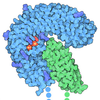登録情報 データベース : PDB / ID : 5zsgタイトル Crystal structure of monkey TLR7 in complex with gardiquimod Toll-like receptor 7 キーワード / 機能・相同性 分子機能 ドメイン・相同性 構成要素
/ / / / / / / / / / / / / / / / / / / / / / / / / / / / / / / 生物種 Macaca mulatta (アカゲザル)手法 / / / 解像度 : 2.3 Å データ登録者 Zhang, Z. / Ohto, U. / Shimizu, T. ジャーナル : Cell Rep / 年 : 2018タイトル : Structural Analyses of Toll-like Receptor 7 Reveal Detailed RNA Sequence Specificity and Recognition Mechanism of Agonistic Ligands.著者 : Zhang, Z. / Ohto, U. / Shibata, T. / Taoka, M. / Yamauchi, Y. / Sato, R. / Shukla, N.M. / David, S.A. / Isobe, T. / Miyake, K. / Shimizu, T. 履歴 登録 2018年4月28日 登録サイト / 処理サイト 改定 1.0 2019年1月30日 Provider / タイプ 改定 2.0 2020年7月29日 Group Advisory / Atomic model ... Advisory / Atomic model / Data collection / Derived calculations / Structure summary カテゴリ atom_site / chem_comp ... atom_site / chem_comp / entity / pdbx_branch_scheme / pdbx_chem_comp_identifier / pdbx_entity_branch / pdbx_entity_branch_descriptor / pdbx_entity_branch_link / pdbx_entity_branch_list / pdbx_entity_nonpoly / pdbx_nonpoly_scheme / pdbx_struct_assembly_gen / pdbx_validate_close_contact / struct_asym / struct_conn / struct_site / struct_site_gen Item _atom_site.B_iso_or_equiv / _atom_site.Cartn_x ... _atom_site.B_iso_or_equiv / _atom_site.Cartn_x / _atom_site.Cartn_y / _atom_site.Cartn_z / _atom_site.auth_asym_id / _atom_site.auth_atom_id / _atom_site.auth_comp_id / _atom_site.auth_seq_id / _atom_site.label_asym_id / _atom_site.label_atom_id / _atom_site.label_comp_id / _atom_site.label_entity_id / _atom_site.type_symbol / _chem_comp.name / _chem_comp.type / _pdbx_entity_nonpoly.entity_id / _pdbx_entity_nonpoly.name / _pdbx_struct_assembly_gen.asym_id_list / _pdbx_validate_close_contact.auth_asym_id_1 / _pdbx_validate_close_contact.auth_seq_id_1 / _struct_conn.pdbx_role / _struct_conn.ptnr1_auth_asym_id / _struct_conn.ptnr1_auth_seq_id / _struct_conn.ptnr1_label_asym_id / _struct_conn.ptnr2_auth_asym_id / _struct_conn.ptnr2_auth_seq_id / _struct_conn.ptnr2_label_asym_id 解説 / Provider / タイプ 改定 2.1 2024年3月13日 Group / Database references / Structure summaryカテゴリ chem_comp / chem_comp_atom ... chem_comp / chem_comp_atom / chem_comp_bond / citation / citation_author / database_2 Item _chem_comp.pdbx_synonyms / _citation.country ... _chem_comp.pdbx_synonyms / _citation.country / _citation.journal_abbrev / _citation.journal_id_CSD / _citation.journal_id_ISSN / _citation.journal_volume / _citation.page_first / _citation.page_last / _citation.pdbx_database_id_DOI / _citation.pdbx_database_id_PubMed / _citation.title / _citation.year / _database_2.pdbx_DOI / _database_2.pdbx_database_accession 改定 2.2 2024年11月13日 Group カテゴリ / pdbx_modification_featureItem
すべて表示 表示を減らす
 データを開く
データを開く 基本情報
基本情報 要素
要素 キーワード
キーワード 機能・相同性情報
機能・相同性情報
 X線回折 /
X線回折 /  シンクロトロン /
シンクロトロン /  分子置換 / 解像度: 2.3 Å
分子置換 / 解像度: 2.3 Å  データ登録者
データ登録者 引用
引用 ジャーナル: Cell Rep / 年: 2018
ジャーナル: Cell Rep / 年: 2018 構造の表示
構造の表示 Molmil
Molmil Jmol/JSmol
Jmol/JSmol ダウンロードとリンク
ダウンロードとリンク ダウンロード
ダウンロード 5zsg.cif.gz
5zsg.cif.gz PDBx/mmCIF形式
PDBx/mmCIF形式 pdb5zsg.ent.gz
pdb5zsg.ent.gz PDB形式
PDB形式 5zsg.json.gz
5zsg.json.gz PDBx/mmJSON形式
PDBx/mmJSON形式 その他のダウンロード
その他のダウンロード 5zsg_validation.pdf.gz
5zsg_validation.pdf.gz wwPDB検証レポート
wwPDB検証レポート 5zsg_full_validation.pdf.gz
5zsg_full_validation.pdf.gz 5zsg_validation.xml.gz
5zsg_validation.xml.gz 5zsg_validation.cif.gz
5zsg_validation.cif.gz https://data.pdbj.org/pub/pdb/validation_reports/zs/5zsg
https://data.pdbj.org/pub/pdb/validation_reports/zs/5zsg ftp://data.pdbj.org/pub/pdb/validation_reports/zs/5zsg
ftp://data.pdbj.org/pub/pdb/validation_reports/zs/5zsg リンク
リンク 集合体
集合体
 要素
要素


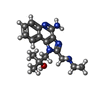




 X線回折 / 使用した結晶の数: 1
X線回折 / 使用した結晶の数: 1  試料調製
試料調製 シンクロトロン / サイト:
シンクロトロン / サイト:  Photon Factory
Photon Factory  / ビームライン: AR-NE3A / 波長: 1 Å
/ ビームライン: AR-NE3A / 波長: 1 Å 解析
解析 分子置換 / 解像度: 2.3→47.202 Å / SU ML: 0.26 / 交差検証法: FREE R-VALUE / σ(F): 1.33 / 位相誤差: 22.46
分子置換 / 解像度: 2.3→47.202 Å / SU ML: 0.26 / 交差検証法: FREE R-VALUE / σ(F): 1.33 / 位相誤差: 22.46  ムービー
ムービー コントローラー
コントローラー









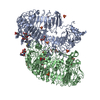





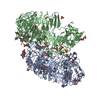




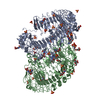





 PDBj
PDBj
